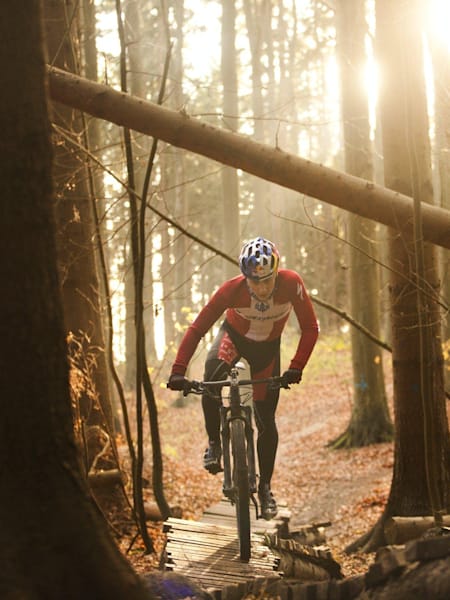When it comes to keeping riding throughout the icy northern hemisphere winter, there's nothing that will make your life easier than sorting out your layering game. The most expensive, thickest jacket that you can find will do you little good if you haven't taken care of what's underneath it.
First and foremost, it's important to accept the first rule of layering; always start a ride cold. When the mercury plummets it's tempting to grab the thickest layers you have, bang them on on top of a couple of jerseys and get moving. Yes, you'll warm up initially, but halfway up the first proper climb you'll be splitting open like some kind of weird Goretex onion. Think through your layering properly and your kit will work with your body to achieve perfect operating temperatures.
Here's a break down of what to look out for.
1. Base
Good base layers are worth their weight in gold, and are essential to staying warm this winter. This is the only layer that sits directly against your skin so how it regulates heat is fundamental to staying comfortable. Some more advanced fabrics wick sweat off away from the skin, which can be a big help.
If you live somewhere really cold, then spending a bit extra on a long-sleeve Merino wool base layer could pay dividends. They are warmer than the usual synthetic fabric mix, but offer improved wicking, are naturally antibacterial and resist odour.
It may be tempting to throw other items back in the kit box for next time, but washing base layers is essential as, unless clean, their proximity to skin can cause irritation. And you'll stink.
2. Mid
Mid layers are just that – a layer between your base and outer numbers. Typically, a normal long-sleeve riding jersey will suffice here.
Specific mid layers are avaiable, but a great option is also to go down the route of wearing a road-style riding jersey. These tend to be tighter cut than their MTB numbers, thicker, as they're often worn as an outer, and handily feature a number of pockets at the rear. These pockets give you the option of adding an additional gillet and a pair of thinner, more technical gloves for tackling steeper descents.
3. Outer
Jackets are the only layer anyone else will ever probably see so it's understandable that we can all be guilty of a bit of peacocking when it comes to them. Yes, looks, pockets and colours are important, but fit is paramount when it comes to keeping in that peak operating temperature window.
Adjustable cuffs and collars are handy for sealing heat in and moisture out, and zips with added tags are easier to operate in gloves. Waterproofing is essential, but thick padding isn't. Instead, why not save some cash, get a waterproof shell and just add an extra mid layer?
Be careful when washing waterproof garments however as you can easily remove the coating, rendering them pretty useless. A neck warmer will keep your neck warm, but can also act like a cork to help keep heat inside your jacket. They're another handy, easily removable layer.
4. Extremities
Your hands and feet are as far away from your heart as it's possible for the body to get, and so getting nice, warm blood out to them can be tricky. Normal gloves are a good starting point, but if they're not warm enough then have a look at cold weather specific numbers. Remember, your palm stays pretty warm when holding on to the bars so watch out for chunky padded palms, which only really seem to create arm pump.
Bib shorts are a good way to keep your core warm too, and 3/4 length leg numbers will offer even more heat. Over shoes may be popular in road riding, but when used off road they can often end up clasping cold mud and water against the shoe, adding to the cold. They're also a nightmare to get off with cold hands.
Thicker, heavy duty cold weather socks are recommended, as are the more expensive waterproof variety.
5. Bonus tips
- Riding glasses are a good way to prevent your eyes from watering up in the cold, and to help ward off flying splatter.
- Have a think about where you stash energy bars and other things you may want quick access to so you save on having to stop for long periods to fish around in a pack.
- Stopping for lunch? If possible, without looking like an idiot, keep your helmet on to avoid the sweat impregnated pads becoming icy blocks of negative energy.
- Invest in a pair of slide-style flip-flops for milling about the van on your return. They can be easily pulled on and will mean that you won't have to get fully changed or risk mudding up your clean shoes to sort out yout kit.











